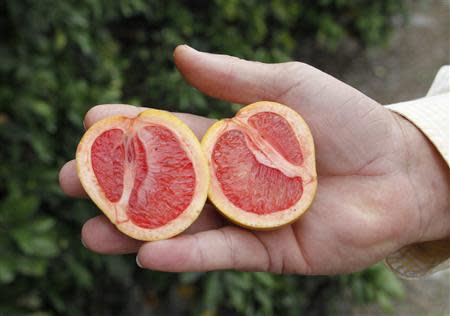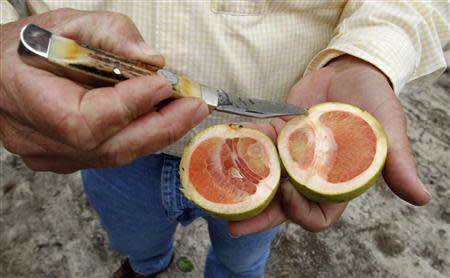Florida counts on experimental trees to fight orange plague
By Barbara Liston ORLANDO, Florida (Reuters) - Florida citrus researchers are preparing to launch a large-scale test of new disease-tolerant orange tree rootstock in what one likened to a leap of faith to save the $9 billion state industry from a deadly citrus greening "tsunami." Florida, second to Brazil in global orange juice production, has lost billions of dollars in revenues from the disease that is killing orange trees faster than they can be replaced. Citrus greening, which makes the fruit unpalatable and kills trees within a few years, has helped put state orange production on a downward trend. The bacteria threatens an industry that employs more than 76,000 full- and part-time workers and provides over 90 percent of orange juice consumed in the United States. So desperate are growers to find a solution to the greening crisis that they are prepared to start planting the new rootstock before testing on it is even completed, researchers say. "This is a huge, risky experiment. It illustrates the desperate situation the Florida citrus industry feels that it is in," said Fred Gmitter, a University of Florida horticulture professor who is part of the test team. Plant pathologists believe citrus greening, caused by a bacterium spread by the Asian Citrus Psyllid, infects as much as 70 percent of Florida's citrus trees, according to researcher Jude Grosser. While searching generally for new rootstocks that would allow trees to thrive despite poor soil, cold temperatures or other stresses, Gmitter and Grosser discovered orange trees grafted onto certain test rootstock planted within large groves survived infection with greening. Under normal circumstances, Gmitter said, researchers would conduct further tests before jumping into a large trial. LIFE AND DEATH FOR THE GROVES Gmitter said the greening disease sweeping Florida prompted the Citrus Research Development Foundation to fund the immediate implementation of promising solutions, including the planting of several thousand of the new rootstock around the state. "Growers have come to see our small trials with these trees where it looks really good. It's like black and white, life and death," Gmitter said, adding, "I'd say it's very likely these rootstocks are going to make a difference." Citrus greening was first discovered in Florida in 2005, the year a parade of hurricanes criss-crossed the groves. The fast-spreading disease has cost Florida's economy an estimated $4.5 billion in lost revenues since 2006, according to the University of Florida's Institute of Food and Agriculture Sciences. Greening was detected in 2012 in California. Total acreage of citrus groves and the number of citrus trees in Florida in 2013 were down for the ninth consecutive survey conducted by the U.S. Department of Agriculture. Damage from hurricanes, cold weather and other diseases also contributed to the decline. Total citrus production for the 2012-13 season declined 9 percent and the on-tree value of the fruit was down 32 percent compared with the previous season. Growers had invested heavily over the years in just a few varieties of fruit that grow well in Florida, particularly Valencia and Hamlin oranges. That limited genetic diversity in the fields and left the industry vulnerable to disease. The University of Florida scientists have maintained a diverse collection of citrus plants and have been cross-breeding different varieties in their search for better rootstock on which to graft the Valencia and Hamlin trees. These cultivars are naturally genetically different and appear more tolerant to greening, although the researchers do not know exactly why. Among possible explanations are that the root system's ability to effectively deliver nutrition might shore up the tree's ability to stave off disease, or that something excreted by the root might suppress the bacteria as it progresses through the plant. Gmitter and Grosser are working to quickly propagate enough new rootstocks for a trial covering several hundred acres in various parts of the state. They estimate the trees will be ready for planting by spring 2015. 'GOT TO HAVE IT NOW' The university intends to make the trees available for purchase even while the trial is under way. Gmitter said growers who would normally wait to see data on a new cultivar's production, juice quality and other factors don't want to wait. The Florida Department of Citrus, in a market projection report in March, found the state's total citrus production on a "steady declining trend." It said the long-run outlook for the industry was "precarious." Tree mortality rates have persistently exceeded planting rates, setting a downward course for production, according to the report, Florida Citrus Production and Projections, 2014-15 through 2022-2023. "We're not waiting until the trial is over, because we've had so many growers who have seen our trees in the small trials who say this is what we want. We've got to have it now," Gmitter said. (Editing by Jane Sutton and Andrew Hay)


